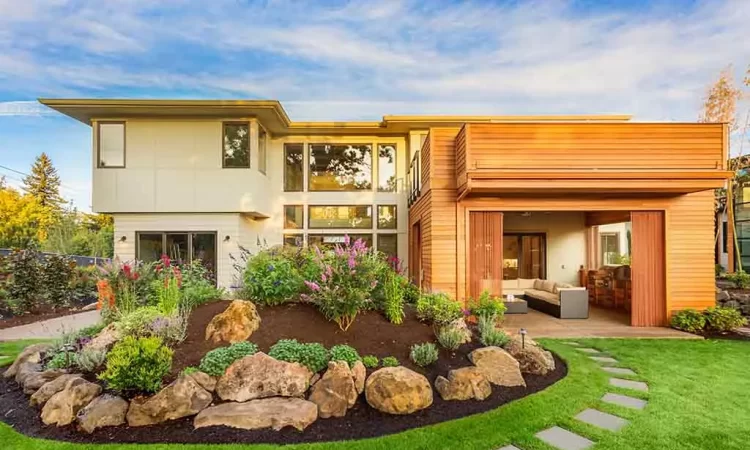
Those who are familiar with Australia understand the difficulty of finding unique landscaping options. Many plants cannot survive the hot, humid summers here. As if that weren’t bad enough, the area is prone to floods, which kills grass and drowns plant roots. In addition, the native clay-heavy soil is inhospitable to many plant species. Here are 10 landscaping options for your yard that require little upkeep if you find caring for your grass to be a chore.
1. Man-made grass
This is the most basic strategy for creating a visually beautiful yard with minimal effort. With artificial grass, you won’t have to worry about the yard being destroyed by drought, flooding, or extreme heat.
Reason being, natural grasses can’t survive in the harsh conditions that artificial turf can. Natural disasters won’t damage the fake grass, and it can readily withstand a lot of foot traffic. Artificial grass is a bad landscaping choice because it is detrimental to the environment, yet it is long lasting and requires little upkeep once it is set up.
2.Plants used as a groundcover
In place of turf grass, you can go with groundcover plants if you don’t want a synthetic lawn or the hassle of maintaining it. The lush, living appearance of groundcover plants belies the fact that they require no mowing.
There is a wide selection of groundcover plants available, both in terms of type and colour. There are some that appear just like actual grass, green and lush, and others that have brightly coloured flowers that bloom at certain periods of the year. Periwinkle, Mondo Grass, and Bugleweed are three of the best groundcover plants for consideration.
3.Ideas for a Hardscape
Putting in a hardscape feature can increase the value of your home and decrease the amount of time you spend maintaining your landscaping. Decks, patios, retaining walls, paths, and gazebos are all examples of hardscaping features that can be installed in a yard instead of living plants.
The only form of upkeep needed for hardscape is the occasional cleaning. Hardscapes, on the other hand, might take up a lot of room in a yard that could be used for grass or low-maintenance plants.
If you don’t take the time to create a sturdy foundation before laying pavers or flagstones, you may find that flooding or other problems in the future cause the stones to shift, resulting in a landscape that needs substantial cleaning and repair.
4.Native flora
If you want low-upkeep landscaping in Australia, native plants are your best bet. Native trees, shrubs, flowers, and other plants in Texas typically require less maintenance than their non-native counterparts. Because of Australia’s hot and humid environment, non-native plants cannot thrive without regular human intervention in the form of watering, fertilising, and pest management.
5.Evergreens
Low-maintenance lawn alternatives include not only local flora but also evergreens. The leaves of evergreen trees, shrubs, and groundcovers remain on the plant throughout the winter. Because of this, your lawn will still seem lush and green in the fall, when most other plants are losing their leaves.
Cherry laurels, American hollies, and a wide variety of palm trees are some of the most popular evergreens in Houston, Texas, gardens.
6.Permanent vegetation
A low-maintenance yard also makes use of perennial plants. Since perennials regrow each year without any extra work from you, they are a great investment for your yard. Without constantly replanting fresh flowers, you can keep your groundcover looking rich and green with these plants.
Daffodils, Yarro, and butterfly weed are three of the nicest perennial plants you can cultivate in your yard.
7.Put in a rain garden.
When compared to a traditional garden, a rain garden requires very less upkeep. The reason for this is that a rain garden may practically self-water because it catches storm-water run-off. After a rain garden has been built and placed, it requires minimal care to ensure its continued success. A rain garden is not only low-maintenance but also beneficial to the local ecosystem since it filters toxins out of rainfall before it flows into waterways.
8.Go with xeriscape landscaping.
Another option for Australians who want a low-maintenance yard is xeriscaping. This is due to the fact that xeriscapes require very little water to thrive. Stones, succulents, and other drought-resistant plants mean you won’t have to hand-water it very often.
The gulf muhly, desert willows, and red yucca are some of the best plants for Xeriscaping.
9. Gardening in containers
Some homeowners simply do not enjoy getting their knees dirty while tending to their plants. If you fall into this category, a container garden is a great way to spruce up your outdoor space.
Plants in bags, boxes, pots, and other decorative containers make up a container garden. These are more manageable for persons with restricted mobility, although they can look just as nice as a traditional garden. Even in the hot climate, tropical plants can be grown successfully in a container garden. When the temperature drops dangerously low, bringing the plant inside is the best way to keep it from freezing to death. You can save time and money by not having to cover your plants throughout the winter.
10. Garden of Rocks
A rock garden is mostly composed of rocks, boulders, stones, and gravel of varying sizes and shapes. A rock garden is similar to the pet rock you may have had as a child, with the exception that a rock garden does not need to be cared for.
Conclusion
Artificial plants, groundcover plants, hardscaping, planting native species, planting evergreen and perennial plants, creating a rain garden, Xeriscaping, container gardens, and rock gardens are among the top 10 low-maintenance lawn options for your yard.
Professional landscapers in Melbourne and lawn care specialists in Brisk landscaping can help you determine which plant species would be best for your climate and upkeep preferences.
